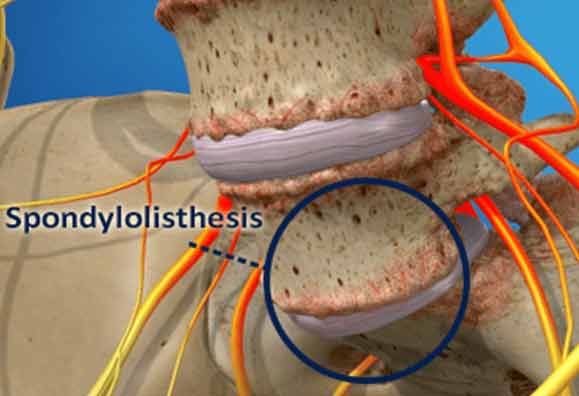The term spondylolisthesis derives from two words: spondylo, which means spine, and listhesis, which means slippage.
Spondylolisthesis is a condition in which a vertebra in the spinal column slips backward or forward and out of its original place, when compared to the vertebra adjacent to it. If a vertebra slips too much, it can press on a spinal nerve and cause pain.
Spondylolisthesis often begins in the teenage years and is most commonly diagnosed in adults.
Spondylolisthesis can also be associated with deterioration of the facet joints that connect vertebrae. As the facet joints become arthritic due to deterioration, they enlarge in an attempt to maintain the stability of the spine.
Spondylolisthesis may occur anywhere within the spinal column, though, it is more prevalent in the lumbar spine.
Spondylolisthesis symptoms can cause compressive or neurogenic symptoms. The forward slip of a vertebra makes the spinal canal smaller, leaving less room for the nerve roots running between the vertebrae. The combination of spinal canal narrowing and enlargement of the facet joints produces the characteristics of nerve compression problems found in degenerative spondylolisthesis. Symptoms include:
- Lower back pain
- Buttock pain
- Pain that runs down the back of the leg
- Weakness in the legs
- Tingling or numbness
- Pain that gets worse with a twist or bending over
- Muscle strain-like discomfort
Can It Be Treated?
Persistent pain as a result of spondylolisthesis can reduce mobility and lead to inactivity that can result in weight gain, loss of bone density, muscle atrophy and loss of flexibility. But there are long-term options. Surgical treatment for spondylolisthesis must address nerve compression symptoms if they are present. This usually means that the nerves that exit the spine must be freed of all pressure and irritation.
The Bonati Spine Procedures offer an array of surgical techniques to treat spondylolisthesis, which may include:
- A laminotomy/laminectomy , which is a decompression surgery for spinal stenosis and involves making an opening in the lamina to relieve pressure on the affected area and allow the nerve roots room to heal. This procedure is often utilized in order to give the surgeon the proper space to perform a foraminotomy/foraminectomy.
- A foraminectomy/foraminotomy, which is a decompression surgery, performed in order to increases the space of the foramen and hollow out the passageway where the nerve roots exit the spinal canal. The procedure involves the removal of bone or tissue that obstructs the neuroforamen and compresses the nerve roots leading to inflammation and radiating pain. During this procedure, the surgeons utilize specialized instrumentations to decompress the nerve roots as they exit through the foramen.
- A discectomy, which involves the removal of a portion of the intervertebral disc that is putting pressure on the spinal cord or radiating nerves. A discectomy may be performed as part of the treatment for spondylolisthesis if the disc at the affected level is herniated.
Get Help!
Our team of surgeons, clinic staff, patient advocates and more are here to help with all your questions and find a solution to your pain. With over 35 years of experience and more than 70,000 successful procedures performed, the Bonati Spine Institute achieves a 98.75% patient satisfaction rate. Allow our physicians and staff to review your case and verify if the Bonati Spine Procedures can help you. To get started, click here to complete our contact form or call us at 855-267-0482.

